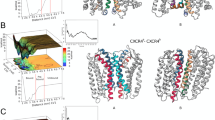Abstract
Based on our theory, we point out main triplets of amino acid residues in the GABAB1 receptor, found in the central and peripheral nervous system, which seem to be critical for both receptor heterodimerization and chemokine binding. The obtained results suggest that these triplets may “guide-and-clasp” protein–protein interactions playing a role, e.g., in neuroinflammation disorders.




Similar content being viewed by others
References
Adya N, Zhao LJ, Huang W, Boros I, Giam CZ (1994) Expansion of CREB’s DNA recognition specificity by Tax results from interaction with Ala-Ala-Arg at position 282–284 near the conserved DNA-binding domain of CREB. Proc Natl Acad Sci USA 91:5642–5646
Agnati LF, Ferré S, Lluis C, Franco R, Fuxe K (2003) Molecular mechanisms and therapeutical implications of intramembrane receptor/receptor interactions among heptahelical receptors with examples from the striatopallidal GABA neurons. Pharmacol Rev 55(3):509–550
Agnati LF, Guidolin D, Albertin G et al (2010) An integrated view on the role of receptor mosaics at perisynaptic level: focus on adenosine A2A, dopamine D2, cannabinoid CB1 and metabotropic glutamate mGlu5 receptors. J Rec Sig Transduc 30(5):355–369
Baardsnes J, Jelokhani-Niaraki J, Kondejewski LH et al (2001) Antifreeze protein from shorthorn sculpin: identification of the ice-binding surface. Protein Sci 10(12):2566–2576
Borroto-Escuela DO, Narvaez M, Marcellino D et al (2010a) Galanin receptor-1 modulates 5-hydroxtryptamine-1A signaling via heterodimerization. Biochem Biophys Res Commun 393:767–772
Borroto-Escuela DO, Romero-Fernandez W, Tarakanov AO et al (2010b) Dopamine D2 and 5-hydroxytryptamine 5-HT2A receptors assemble into functionally interacting heteromers. Biochem Biophys Res Commun 401:605–610
Borroto-Escuela DO, Romero-Fernandez W, Tarakanov AO et al (2010c) Characterization of the A2AR-D2R interface: focus on the role of the C-terminal tail and the transmembrane helices. Biochem Biophys Res Commun 402:801–807
Charo IF, Ransohoff RM (2006) The many roles of chemokines and chemokine receptors in inflammation. N Eng J Med 354(6):610–621
Ciruela F, Burqueño J, Casadó V et al (2004) Combining mass spectrometry and pull-down techniques for the study of receptor heteromerization. Direct epitope-epitope electrostatic interactions between adenosine A2A and dopamine D2 receptors. Anal Chem 76(18):5354–5363
Das AK, Cohen PTW, Barford D (1998) The structure of the tetratricopeptide repeats of protein phosphatase5: implications for TPR-mediated protein–protein interactions. EMBO J 17(5):1192–1199
Fuxe K, Ferré S, Canals M et al (2005) Adenosine A2A and dopamine D2 heteromeric receptor complexes and their function. J Mol Neurosci 26(2–3):209–220
Fuxe K, Canals M, Torvinen M et al (2007) Intramembrane receptor–receptor interactions: a novel principle in molecular medicine. J Neural Transm 114(1):49–75
Goncharova LB, Tarakanov AO (2008) Why chemokines are cytokines while their receptors are not cytokine ones? Curr Med Chem 15(13):1297–1304
Gurevich VV, Gurevich EV (2008) How and why do GPCRs dimerize? Trends Pharmacol Sci 29:234–240
Guyon A, Nahon JL (2007) Multiple actions of the chemokine stromal cell-derived factor-1a on neuronal activity. J Mol Endocrinol 38:365–376
Hirono M, Yoshioka T, Konishi S (2001) GABA(B) receptor activation enhances mGluR-mediated responses at cerebellar excitatory synapses. Nat Neurosci 4:1207–1216
Kikuno R, Nagase T, Nakayama M et al (2004) HUGE: a database for human KIAA proteins, a 2004 update integrating HUGEppi and ROUGE. Nucleic Acids Res 32:D502–D504
König R, Zhou Y, Elleder D et al (2008) Global analysis of host-pathogen interactions that regulate early-stage HIV-1 replication. Cell 135:49–60
Marshall FH (2005) Is the GABA B heterodimer a good drug target? J Mol Neurosci 26(2–3):169–176
Marshall FH, Jones KA, Kaupmann K, Bettler B (2001) GABAB receptors—the first 7TM heterodimers. Trends Pharmacol Sci 20(10):396–399
Moran MF, Koch CA, Sadowski I, Pawson T (1988) Mutational analysis of a phosphotransfer motif essential for v-fps tyrosine kinase activity. Oncogene 3(6):665–672
NCBI (2010) National center for biotechnology information (http://www.ncbi.nlm.nih.gov)
Pin JP, Neubig R, Bouvier M et al (2007) International union of basic and clinical pharmacology. LXVII. Recommendations for the recognition and Nomenclature of G protein-coupled receptor heteromultimers. Pharmacol Rev 59:5–13
Rocheville M, Lange DC, Kumar U, Sasi R, Patel SC, Patel YC (2000) Subtypes of the somatostatin receptor assemble as functional homo- and heterodimers. J Biol Chem 275:7862–7869
Tang Y, Tie F, Boros I, Harrod R, Glover M, Giam CZ (1998) An extended α-helix and specific amino acid residues opposite the DNA-binding surface of the cAMP response element binding protein basic domain are important for human t cell lymphotropic retrovirus type I Tax binding. J Biol Chem 273(42):27339–27346
Tarakanov AO, Fuxe KJ (2010) Triplet puzzle: homologies of receptor heteromers. J Mol Neurosci 41(2):294–303
Tobin AB, Butcher AJ, Kong KC (2008) Location, location, location… site-specific GPCR phosphorylation offers a mechanism for cell-type-specific signalling. Trends Pharmacol Sci 29(8):413–420
Vendel AC, McBryant SJ, Lumb KJ (2003) KIX-mediated assembly of the CBP−CREB−HTLV-1 Tax coactivator–activator complex. Biochem 42:12481–12487
Woods AS (2004) The mighty arginine, the stable quaternary amines, the powerful aromatics, and the aggressive phosphate: their role in the noncovalent minuet. J Proteome Res 3(3):478–484
Woods AS, Ciruela F, Fuxe K et al (2005) Role of electrostatic interaction in receptor–receptor heteromerization. J Mol Neurosci 26(2–3):125–132
Woods AS, Marcellino D, Jackson SN et al (2008) How calmodulin interacts with the adenosine A2A and the dopamine D2 receptotrs. J Proteome Res 7(8):3428–3434
Author information
Authors and Affiliations
Corresponding author
Rights and permissions
About this article
Cite this article
Tarakanov, A.O., Fuxe, K.G. The Triplet Puzzle of Homologies in Receptor Heteromers Exists Also in Other Types of Protein–Protein Interactions. J Mol Neurosci 44, 173–177 (2011). https://doi.org/10.1007/s12031-011-9511-9
Received:
Accepted:
Published:
Issue Date:
DOI: https://doi.org/10.1007/s12031-011-9511-9




